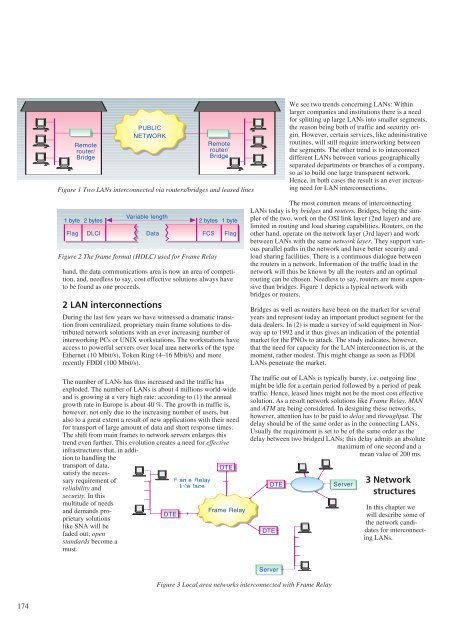Prognosemetoder – en oversikt - Telenor
Prognosemetoder – en oversikt - Telenor
Prognosemetoder – en oversikt - Telenor
You also want an ePaper? Increase the reach of your titles
YUMPU automatically turns print PDFs into web optimized ePapers that Google loves.
174<br />
Remote<br />
router/<br />
Bridge<br />
hand, the data communications area is now an area of competition,<br />
and, needless to say, cost effective solutions always have<br />
to be found as one proceeds.<br />
2 LAN interconnections<br />
During the last few years we have witnessed a dramatic transition<br />
from c<strong>en</strong>tralized, proprietary main frame solutions to distributed<br />
network solutions with an ever increasing number of<br />
interworking PCs or UNIX workstations. The workstations have<br />
access to powerful servers over local area networks of the type<br />
Ethernet (10 Mbit/s), Tok<strong>en</strong> Ring (4<strong>–</strong>16 Mbit/s) and more<br />
rec<strong>en</strong>tly FDDI (100 Mbit/s).<br />
The number of LANs has thus increased and the traffic has<br />
exploded. The number of LANs is about 4 millions world-wide<br />
and is growing at a very high rate: according to (1) the annual<br />
growth rate in Europe is about 40 %. The growth in traffic is,<br />
however, not only due to the increasing number of users, but<br />
also to a great ext<strong>en</strong>t a result of new applications with their need<br />
for transport of large amount of data and short response times.<br />
The shift from main frames to network servers <strong>en</strong>larges this<br />
tr<strong>en</strong>d ev<strong>en</strong> further. This evolution creates a need for effective<br />
infrastructures that, in addition<br />
to handling the<br />
transport of data,<br />
satisfy the necessary<br />
requirem<strong>en</strong>t of<br />
reliability and<br />
security. In this<br />
multitude of needs<br />
and demands proprietary<br />
solutions<br />
like SNA will be<br />
faded out; op<strong>en</strong><br />
standards become a<br />
must.<br />
PUBLIC<br />
NETWORK<br />
Remote<br />
router/<br />
Bridge<br />
Figure 1 Two LANs interconnected via routers/bridges and leased lines<br />
Variable l<strong>en</strong>gth<br />
1 byte 2 bytes 2 bytes 1 byte<br />
Flag DLCI Data<br />
FCS Flag<br />
Figure 2 The frame format (HDLC) used for Frame Relay<br />
DTE<br />
Frame Relay<br />
Interface<br />
DTE<br />
Frame Relay<br />
We see two tr<strong>en</strong>ds concerning LANs: Within<br />
larger companies and institutions there is a need<br />
for splitting up large LANs into smaller segm<strong>en</strong>ts,<br />
the reason being both of traffic and security origin.<br />
However, certain services, like administrative<br />
routines, will still require interworking betwe<strong>en</strong><br />
the segm<strong>en</strong>ts. The other tr<strong>en</strong>d is to interconnect<br />
differ<strong>en</strong>t LANs betwe<strong>en</strong> various geographically<br />
separated departm<strong>en</strong>ts or branches of a company,<br />
so as to build one large transpar<strong>en</strong>t network.<br />
H<strong>en</strong>ce, in both cases the result is an ever increasing<br />
need for LAN interconnections.<br />
The most common means of interconnecting<br />
LANs today is by bridges and routers. Bridges, being the simpler<br />
of the two, work on the OSI link layer (2nd layer) and are<br />
limited in routing and load sharing capabilities. Routers, on the<br />
other hand, operate on the network layer (3rd layer) and work<br />
betwe<strong>en</strong> LANs with the same network layer. They support various<br />
parallel paths in the network and have better security and<br />
load sharing facilities. There is a continuous dialogue betwe<strong>en</strong><br />
the routers in a network. Information of the traffic load in the<br />
network will thus be known by all the routers and an optimal<br />
routing can be chos<strong>en</strong>. Needless to say, routers are more exp<strong>en</strong>sive<br />
than bridges. Figure 1 depicts a typical network with<br />
bridges or routers.<br />
Bridges as well as routers have be<strong>en</strong> on the market for several<br />
years and repres<strong>en</strong>t today an important product segm<strong>en</strong>t for the<br />
data dealers. In (2) is made a survey of sold equipm<strong>en</strong>t in Norway<br />
up to 1992 and it thus gives an indication of the pot<strong>en</strong>tial<br />
market for the PNOs to attack. The study indicates, however,<br />
that the need for capacity for the LAN interconnection is, at the<br />
mom<strong>en</strong>t, rather modest. This might change as soon as FDDI<br />
LANs p<strong>en</strong>etrate the market.<br />
The traffic out of LANs is typically bursty, i.e. outgoing line<br />
might be idle for a certain period followed by a period of peak<br />
traffic. H<strong>en</strong>ce, leased lines might not be the most cost effective<br />
solution. As a result network solutions like Frame Relay, MAN<br />
and ATM are being considered. In designing these networks,<br />
however, att<strong>en</strong>tion has to be paid to delay and throughput. The<br />
delay should be of the same order as in the connecting LANs.<br />
Usually the requirem<strong>en</strong>t is set to be of the same order as the<br />
delay betwe<strong>en</strong> two bridged LANs; this delay admits an absolute<br />
maximum of one second and a<br />
mean value of 200 ms.<br />
DTE<br />
DTE<br />
Server<br />
Figure 3 Local area networks interconnected with Frame Relay<br />
Server<br />
3 Network<br />
structures<br />
In this chapter we<br />
will describe some of<br />
the network candidates<br />
for interconnecting<br />
LANs.
















